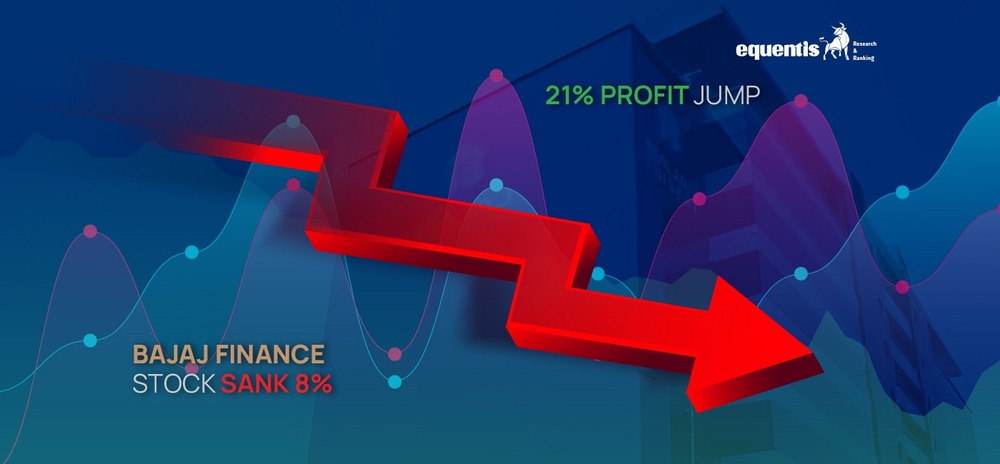Let’s say you have been following a company closely, and they have just released its quarterly results. The numbers are impressive, registering a healthy 21% year-over-year jump in net profit. Sounds like a cause for celebration, right? Well, for Bajaj Finance shareholders, the recent quarter wasn’t quite a victory lap. Despite the strong profit growth, the company’s stock price took an unexpected turn, dropping 7.75%.
So, what exactly caused this disconnect between the company’s financial performance and its stock market performance? Let’s look deeper and find the reasons behind this surprising plunge.
Here’s what happened on Friday
Bajaj Finance shares opened at ₹7,000, down from the previous close ₹7,296. The price continued to slide throughout the day, cracking as much as 7.75% on the National Stock Exchange (NSE) and reaching a low of ₹6,731.
6 Reasons For The Drop In Share Price
1. Market’s Broader Sell-Off:
It’s important to acknowledge the larger market sentiment. The recent period has seen a correction in the Indian stock market, with many sectors experiencing a pullback. Despite its individual performance, Bajaj Finance couldn’t escape this overall market trend. Investors might be adopting a cautious approach, leading to a broader sell-off that also impacted Bajaj Finance’s stock price.
2. Profit Growth Meeting, Not Beating Expectations:
While a 21% net profit increase is undoubtedly positive, market analysts may have anticipated an even higher growth figure. Bajaj Finance might have met expectations, but it didn’t surpass them. In the fast-paced world of the stock market, exceeding expectations is often the key to driving stock prices up. Meeting them, even with a strong showing, might not be enough to excite investors looking for a bigger jump.
3. Concerns Over Net Interest Margin:
Take a closer look at Bajaj Finance’s financials. While they reported a robust 21% year-on-year rise in net profit to ₹3,825 crore for Q4FY24 and a healthy 28% increase in net interest income to ₹8,013 crore compared to the previous year, a key metric seems to have worried investors: the net interest margin (NIM). This figure, which reflects the difference between what Bajaj Finance earns on loans and what it pays on deposits, shrank by 21 basis points (bps) in Q4 compared to Q3.
4. Worries about Asset Quality:
Another factor weighing the stock price is lingering concern about Bajaj Finance’s asset quality. Investors closely watch a company’s ability to recover loans it issues. If there’s a perception that many borrowers might default on their loans, it can spook investors and lead to a sell-off. While Bajaj Finance might not have reported any major issues in this regard, even a hint of potential trouble can cause jitters in the market.
5. Rising Interest Rates:
Another factor that could be weighing on Bajaj Finance’s stock price is the possibility of rising interest rates in India. As interest rates go up, the cost of borrowing for Bajaj Finance increases, potentially squeezing their profit margins in the future. Investors anticipating this scenario might factor it into the current stock price, leading to the decline.
6. Valuation Concerns:
Even with solid financials, Bajaj Finance’s stock price might be a case of correction after a significant run-up in the past. The stock price might have become overvalued by the market, and the recent drop could be a return to a more realistic valuation based on the company’s fundamentals.
So, what’s the next step for Bajaj Finance?
The company must maintain its strong profitability while closely monitoring asset quality. Addressing investor concerns about potential delinquency rates and the impact of rising interest rates will be crucial in regaining investor confidence. Ultimately, Bajaj Finance’s future stock performance will depend on its ability to navigate the current market environment and deliver results that continue to impress investors.
Investor Takeaway
The recent drop in Bajaj Finance’s stock price reminds us that the stock market is quite unpredictable. While a company’s financial performance is crucial, it’s just one piece of the puzzle. Market sentiment, broader economic factors, and investor expectations all play a role in determining a stock’s price.
If you’re a long-term investor focused on Bajaj Finance’s future potential, this drop may be considered an opportunity. Remember, staying informed about the company’s performance and the overall market environment is crucial for making sound investment decisions.
Know more about
IPO | Current IPO | Upcoming IPO | Listed IPO
*Disclaimer Note: The securities quoted, if any, are for illustration only and are not recommendatory. This article is for education purposes only and shall not be considered as recommendation or investment advice by Research & Ranking. We will not be liable for any losses that may occur. Investment in securities market are subject to market risks. Read all the related documents carefully before investing. Registration granted by SEBI, membership of BASL, and certification from NISM in no way guarantee the performance of the intermediary or provide any assurance of returns to investors.
How useful was this post?
Click on a star to rate it!
Average rating 2.2 / 5. Vote count: 5
No votes so far! Be the first to rate this post.
I’m Archana R. Chettiar, an experienced content creator with
an affinity for writing on personal finance and other financial content. I
love to write on equity investing, retirement, managing money, and more.
-
Archana Chettiarhttps://www.equentis.com/blog/author/archana/
-
Archana Chettiarhttps://www.equentis.com/blog/author/archana/
-
Archana Chettiarhttps://www.equentis.com/blog/author/archana/
-
Archana Chettiarhttps://www.equentis.com/blog/author/archana/

